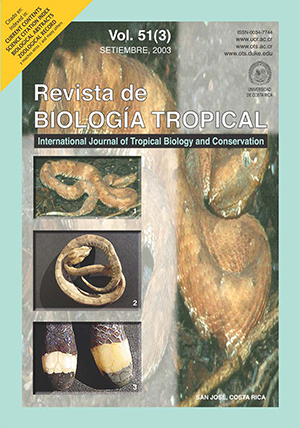Abstract
The reproductive phenology of seven species of Rubiaceae from the Brazilian Atlantic rain forest was compared to evaluate the occurrence of phylogenetic constraints on flowering and fruiting phenologies. Since phenological patterns can be affected by phylogenetic constraints, we expected that reproductive phenology would be similar among plants within a family or genus, occurring during the same time (or season) of the year. Observations on flowering and fruiting phenology were carried out monthly, from December 1996 to January 1998, at Núcleo Picinguaba, Parque Estadual da Serra do Mar, Ubatuba, São Paulo State, Brazil. Nine phenological variables were calculated to characterize, quantify and compare the reproductive phenology of the Rubiaceae species. The flowering patterns were different among the seven species studied, and the Kruskal- Wallis test indicated significant differences in flowering duration, first flowering, peak flowering and flowering synchrony. The peaks and patterns of fruiting intensity were different among the Rubiaceae species studied and they differed significantly from conspecifics in the phenological variables fruiting duration, fruiting peak date, and fruiting synchrony (Kruskal-Wallis test). Therefore, we found no evidence supporting the phylogenetic hypotheses, and climate does not seem to constrain flowering and fruiting patterns of the Rubiaceae species in the understory of the Atlantic forest.##plugins.facebook.comentarios##

This work is licensed under a Creative Commons Attribution 4.0 International License.
Copyright (c) 2003 Revista de Biología Tropical
Downloads
Download data is not yet available.


